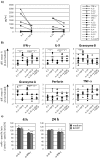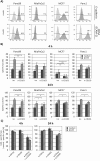TGF-β enhances the cytotoxic activity of Vδ2 T cells
- PMID: 30546961
- PMCID: PMC6287804
- DOI: 10.1080/2162402X.2018.1522471
TGF-β enhances the cytotoxic activity of Vδ2 T cells
Abstract
TGF-β is a pleiotropic cytokine with multiple roles in immunity. Apart from its suppressive activity, TGF-β is a driving cytokine in the differentiation of induced regulatory T cells (iTreg) but also in the polarization of interleukin-9 (IL-9) producing T helper 9 (Th9) T cells. Human Vδ2 expressing γδ T cells exert potent cytotoxicity towards a variety of solid tumor and leukemia/lymphoma target cells and thus are in the focus of current strategies to develop cell-based immunotherapies. Here we report that TGF-β unexpectedly augments the cytotoxic effector activity of short-term expanded Vδ2 T cells when purified γδ T cells are activated with specific pyrophosphate antigens and IL-2 or IL-15 in the presence of TGF-β. TGF-β up-regulates the expression of CD54, CD103, interferon-γ, IL-9 and granzyme B in γδ T cells while CD56 and CD11a/CD18 are down-regulated. Moreover, we show that CD103 (αE/β7 integrin) is recruited to the immunological synapse in γδ T cells. Increased cytotoxic activity of TGF-β-exposed γδ T cells is reduced by anti-CD103 and further diminished upon additional anti-CD11a antibody treatment, pointing to a role of cellular adhesion in the enhanced cytolytic activity. Furthermore, magnetically sorted CD103-positive Vδ2 T cells exhibit superior cytolytic activity. In view of the importance of CD103 for tissue homing of lymphocytes, our results suggest that adoptive transfer of CD103-expressing Vδ2 T cells might favor their homing to solid tumors.
Keywords: CD103; IFN-gamma; TGF-beta; Vdelta2; gamma/delta T cells.
Figures







Similar articles
-
Human Vδ2 T cells are a major source of interleukin-9.Proc Natl Acad Sci U S A. 2016 Nov 1;113(44):12520-12525. doi: 10.1073/pnas.1607136113. Epub 2016 Oct 17. Proc Natl Acad Sci U S A. 2016. PMID: 27791087 Free PMC article.
-
Immune response of human propagated gammadelta-T-cells to neuroblastoma recommend the Vdelta1+ subset for gammadelta-T-cell-based immunotherapy.J Immunother. 2008 Nov-Dec;31(9):896-905. doi: 10.1097/CJI.0b013e31818955ad. J Immunother. 2008. PMID: 18832998
-
Potential Role of Vδ2+ γδ T Cells in Regulation of Immune Activation in Primary HIV Infection.Front Immunol. 2017 Sep 25;8:1189. doi: 10.3389/fimmu.2017.01189. eCollection 2017. Front Immunol. 2017. PMID: 28993778 Free PMC article.
-
Direct and Indirect Effects of Cytomegalovirus-Induced γδ T Cells after Kidney Transplantation.Front Immunol. 2015 Jan 21;6:3. doi: 10.3389/fimmu.2015.00003. eCollection 2015. Front Immunol. 2015. PMID: 25653652 Free PMC article. Review.
-
Integrin αE(CD103)β7 in Epithelial Cancer.Cancers (Basel). 2021 Dec 9;13(24):6211. doi: 10.3390/cancers13246211. Cancers (Basel). 2021. PMID: 34944831 Free PMC article. Review.
Cited by
-
TGFβ control of immune responses in cancer: a holistic immuno-oncology perspective.Nat Rev Immunol. 2023 Jun;23(6):346-362. doi: 10.1038/s41577-022-00796-z. Epub 2022 Nov 15. Nat Rev Immunol. 2023. PMID: 36380023 Free PMC article. Review.
-
Vγ9Vδ2 T Cells: Can We Re-Purpose a Potent Anti-Infection Mechanism for Cancer Therapy?Cells. 2020 Mar 30;9(4):829. doi: 10.3390/cells9040829. Cells. 2020. PMID: 32235616 Free PMC article. Review.
-
Functional Phenotypes of Human Vγ9Vδ2 T Cells in Lymphoid Stress Surveillance.Cells. 2020 Mar 22;9(3):772. doi: 10.3390/cells9030772. Cells. 2020. PMID: 32235722 Free PMC article. Review.
-
Contemplating Dichotomous Nature of Gamma Delta T Cells for Immunotherapy.Front Immunol. 2022 May 20;13:894580. doi: 10.3389/fimmu.2022.894580. eCollection 2022. Front Immunol. 2022. PMID: 35669772 Free PMC article. Review.
-
Tumor-infiltrating lymphocytes in the immunotherapy era.Cell Mol Immunol. 2021 Apr;18(4):842-859. doi: 10.1038/s41423-020-00565-9. Epub 2020 Nov 2. Cell Mol Immunol. 2021. PMID: 33139907 Free PMC article. Review.
References
-
- Buccheri S, Guggino G, Caccamo N, Li DP, Dieli F. Efficacy and safety of gammadeltaT cell-based tumor immunotherapy: a meta-analysis. J Biol Regul Homeost Agents. 2014;28:81–90. PMID: 24750794. - PubMed
-
- Helm O, Mennrich R, Petrick D, Goebel L, Freitag-Wolf S, Röder C, Kalthoff H, Röcken C, Sipos B, Kabelitz D, et al. Comparative characterization of stroma cells and ductal epithelium in chronic pancreatitis and pancreatic ductal adenocarcinoma. PLoS One. 2014;9:e94357 PMID:24797069. doi:10.1371/journal.pone.0094357. - DOI - PMC - PubMed
-
- Oberg HH, Grage-Griebenow E, Adam-Klages S, Jerg E, Peipp M, Kellner C, Petrick D, Gonnermann D, Freitag-Wolf S, Röcken C, et al. Monitoring and functional characterization of the lymphocytic compartment in pancreatic ductal adenocarcinoma patients. Pancreatology. 2016;16:1069–1079. PMID:27424476. doi:10.1016/j.pan.2016.07.008. - DOI - PubMed
-
- Daley D, Zambirinis CP, Seifert L, Akkad N, Mohan N, Werba G, Barilla R, Torres-Hernandez A, Hundeyin M, Mani VRK, et al. gammadelta T cells support pancreatic oncogenesis by restraining alphabeta T cell activation. Cell. 2016;166:1485–1499. PMID:27569912. doi:10.1016/j.cell.2016.07.046. - DOI - PMC - PubMed
Publication types
LinkOut - more resources
Full Text Sources
Other Literature Sources
Research Materials
